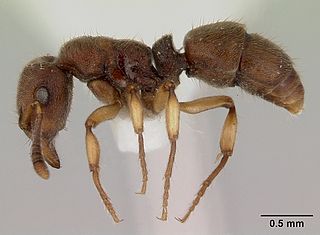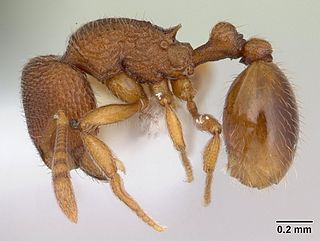
Myrmicinae is a subfamily of ants, with about 140 extant genera; their distribution is cosmopolitan. The pupae lack cocoons. Some species retain a functional sting. The petioles of Myrmicinae consist of two nodes. The nests are permanent and in soil, rotting wood, under stones, or in trees.

Aphaenogaster is a genus of myrmicine ants. About 200 species have been described, including 18 fossil species. They occur worldwide except in South America south of Colombia, sub-Saharan Africa, and Antarctica.

Crematogaster is an ecologically diverse genus of ants found worldwide, which are characterised by a distinctive heart-shaped gaster (abdomen), which gives them one of their common names, the Saint Valentine ant. Members of this genus are also known as cocktail ants because of their habit of raising their abdomens when alarmed. Most species are arboreal (tree-dwelling). These ants are sometimes known as acrobat ants.

Megalomyrmex is a genus of ant in the subfamily Myrmicinae. The genus is known only from the Neotropics, where some of the species are specialized parasites or predators of Attini.

Anochetus is a genus of small, carnivorous ants found in the tropics and subtropics throughout the world.

Procryptocerus is a Neotropical genus of gliding ants, with the ability to "parachute" by steering their fall if they drop off of the tree they're on.

Platythyrea is a genus of predaceous ants in the subfamily Ponerinae and the sole member of the tribe Platythyreini.

Dolichoderus is a genus of ants found worldwide.

Rhopalothrix is a genus of ants in the subfamily Myrmicinae.

Proceratium is a rare genus of ants in the subfamily Proceratiinae. It is the type genus of the tribe Proceratiini, which in addition to Proceratium consists of two even rarer genera: the extant Discothyrea and the fossil genus Bradoponera.

Gnamptogenys is a genus of ants in the subfamily Ectatomminae. The genus has a wide distribution. It is known to occur in the Nearctic, Neotropic, Indomalayan and Australasian realms.

Heteroponera is a genus of ants in the subfamily Heteroponerinae. The genus is known from the Neotropics and Australasia.

Adelomyrmex is a genus of ants in the subfamily Myrmicinae. Species of Adelomyrmex are small, litter-inhabiting ants most often collected in Berlese and Winkler samples. Although the genus and its relatives have a pantropical distribution, Central American cloud forests are the only places where they are abundant and diverse.

Octostruma is a genus of ants in the subfamily Myrmicinae. The genus is found in the Neotropics.

Orectognathus is a genus of ants in the subfamily Myrmicinae.

Nesomyrmex is a genus of ants in the subfamily Myrmicinae. The genus is distributed in the Neotropical, Afrotropical and Malagasy regions. Most species live in arid climates, but some are known from the rainforest. They nest in soil or in trees. Little is known about their biology.

Rogeria is a genus of ant in the subfamily Myrmicinae. The genus is known from the Americas, Pacific, and Caribbean. Little is known about their biology.

















